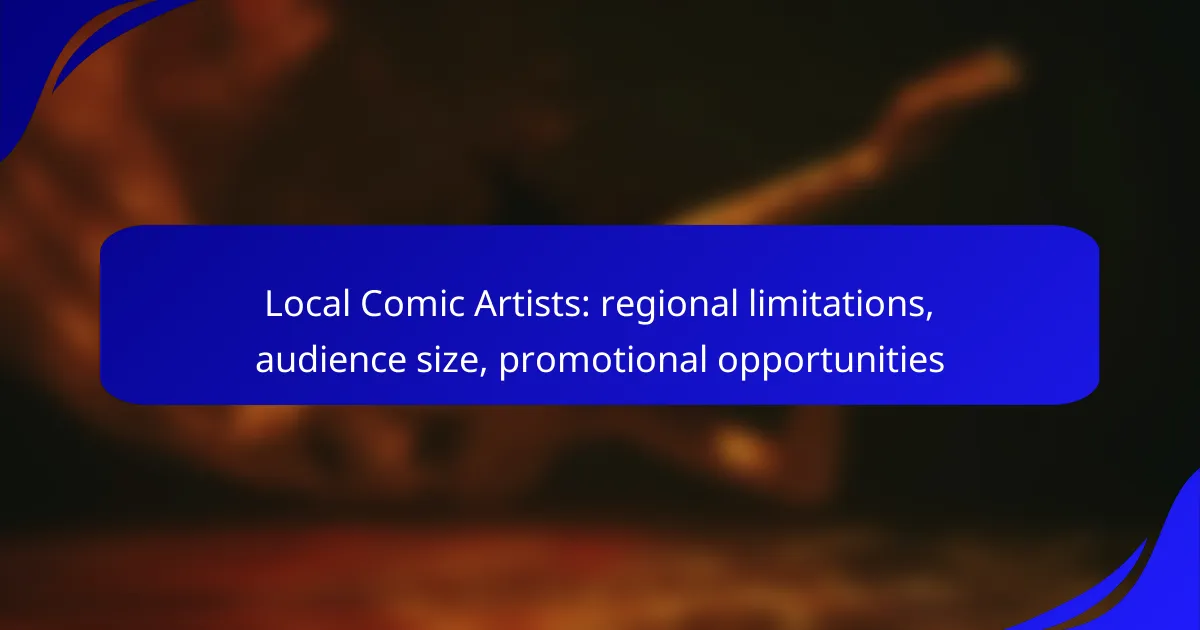Local comic artists face unique challenges due to regional limitations, but they can effectively expand their reach by utilizing digital tools and engaging with their communities. The size of their audience often fluctuates based on local demographics and cultural interests, typically ranging from a few thousand to tens of thousands. By embracing promotional opportunities such as social media, art fairs, and partnerships with local comic shops, these artists can enhance their visibility and foster a loyal following.
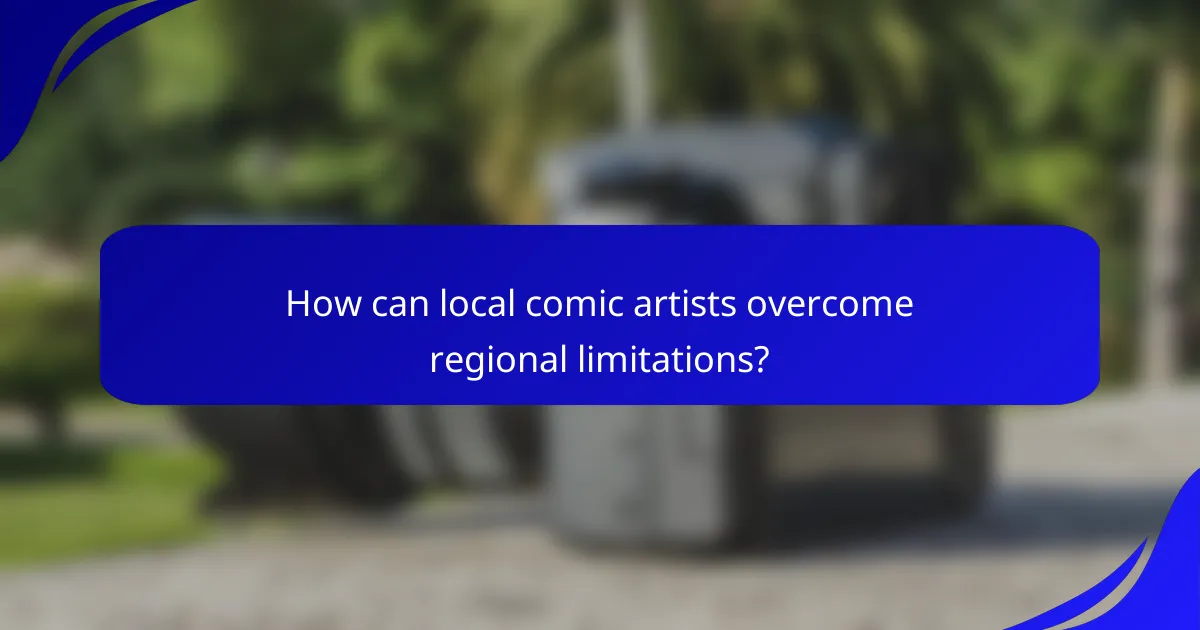
How can local comic artists overcome regional limitations?
Local comic artists can overcome regional limitations by leveraging digital tools, forming partnerships, and engaging with their communities. These strategies help expand their reach, attract a broader audience, and enhance promotional opportunities.
Utilizing online platforms
Online platforms are essential for local comic artists to showcase their work beyond geographical boundaries. Websites, social media, and digital marketplaces allow artists to connect with fans and potential buyers globally. Platforms like Instagram, Etsy, and Webtoon can significantly increase visibility.
Creating a professional website can serve as a central hub for an artist’s portfolio, merchandise, and updates. Artists should focus on search engine optimization (SEO) to improve their online presence and attract organic traffic.
Collaborating with local businesses
Partnering with local businesses can provide comic artists with promotional opportunities and a supportive network. Collaborations can include hosting events at local cafes, bookstores, or galleries, where artists can showcase their work and engage with the community.
Artists might also consider creating exclusive merchandise or artwork for local businesses, which can help both parties reach new customers. Establishing these relationships can foster a sense of community and encourage local support.
Participating in regional conventions
Regional conventions are valuable opportunities for local comic artists to gain exposure and connect with audiences. These events often attract comic enthusiasts, providing a platform for artists to sell their work, network, and receive feedback.
When participating in conventions, artists should prepare by creating an engaging booth, offering promotional materials, and showcasing a variety of their work. Engaging with attendees through workshops or panels can further enhance visibility and establish credibility within the local comic community.

What is the audience size for local comic artists?
The audience size for local comic artists can vary significantly based on regional factors, including population density and cultural interests. Generally, local comic artists may find their audience in the low thousands to tens of thousands, depending on their promotional efforts and community engagement.
Demographics of comic book readers
Comic book readers tend to be diverse, spanning various age groups and backgrounds. Traditionally, the audience has included younger readers, particularly those aged 18 to 34, but there is a growing interest among older demographics as well. Gender representation is also evolving, with more female readers engaging with comics, especially in genres like fantasy and romance.
Local comic artists should consider these demographics when creating their work and marketing strategies. Understanding who their potential readers are can help tailor content and promotional efforts effectively.
Growth trends in comic readership
Comic readership has seen a resurgence in recent years, driven by the popularity of superhero films and graphic novels. This trend has expanded the audience base, attracting new readers who may not have previously engaged with comics. Local comic artists can benefit from this growth by aligning their work with current trends and themes that resonate with audiences.
Additionally, the rise of digital platforms has made comics more accessible, allowing local artists to reach wider audiences beyond their immediate geographical area. Engaging with social media and online marketplaces can significantly enhance visibility and sales opportunities for local creators.
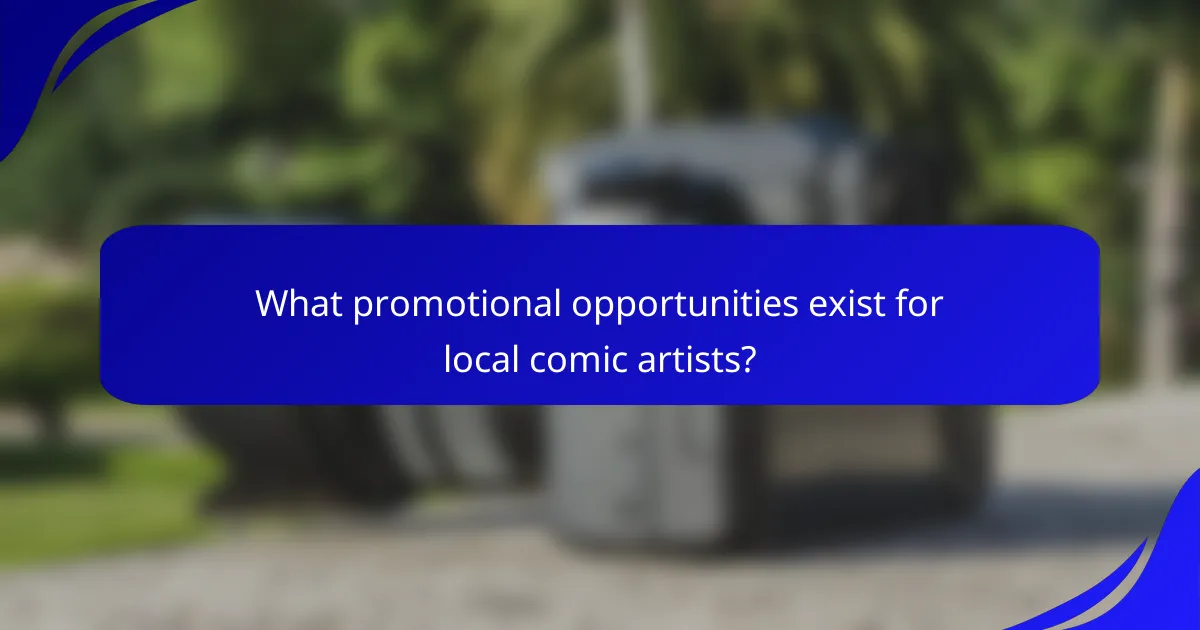
What promotional opportunities exist for local comic artists?
Local comic artists have various promotional opportunities to reach their audience and build their brand. These include leveraging social media, participating in local art fairs, and forming partnerships with comic shops to enhance visibility and sales.
Social media marketing strategies
Social media platforms like Instagram, Twitter, and Facebook are essential for local comic artists to showcase their work and connect with fans. Regularly posting updates, behind-the-scenes content, and engaging with followers can significantly increase visibility.
Consider using targeted ads to reach specific demographics interested in comics. Collaborating with influencers or other artists can also expand your audience. Aim for consistent branding across platforms to create a recognizable presence.
Local art fairs and exhibitions
Participating in local art fairs and exhibitions provides comic artists with direct access to potential buyers and fans. These events often attract art enthusiasts looking for unique pieces, making them ideal for networking and sales.
When preparing for these events, ensure you have a professional display of your work and promotional materials like business cards or flyers. Engaging with attendees and offering limited-time discounts can encourage immediate purchases.
Partnerships with comic shops
Forming partnerships with local comic shops can be a mutually beneficial way to promote your work. Many shops are open to featuring local artists, which can lead to increased sales and visibility within the community.
Consider arranging book signings, workshops, or exclusive releases at these shops to attract customers. Regular communication with shop owners about your upcoming projects can help keep your work in their minds and on their shelves.
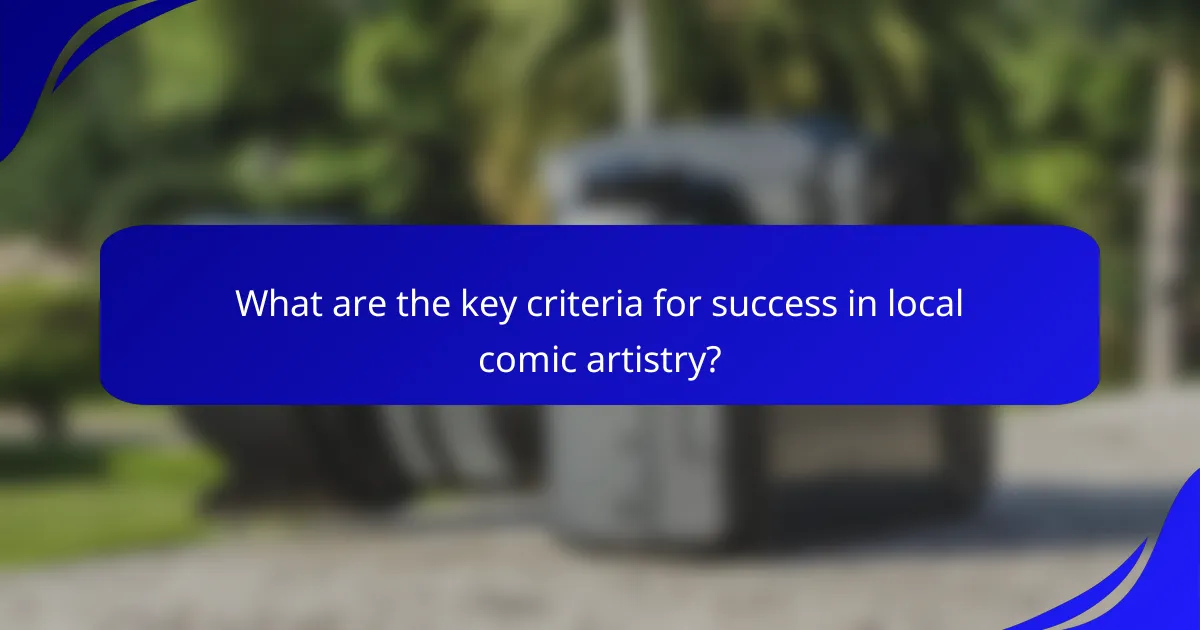
What are the key criteria for success in local comic artistry?
Success in local comic artistry hinges on several key criteria, including the quality of artwork and active engagement with the community. These factors not only enhance visibility but also foster a loyal audience base that appreciates and supports local creators.
Quality of artwork
The quality of artwork is paramount for local comic artists. High-quality illustrations can set a creator apart in a competitive market, attracting readers and potential buyers. Artists should focus on developing a distinctive style while ensuring technical proficiency in drawing, coloring, and layout.
Investing time in practice and seeking constructive feedback can significantly improve an artist’s work. Many successful local artists participate in workshops or online courses to refine their skills and stay updated with industry trends.
Engagement with the community
Engagement with the community is essential for building a supportive audience. Local comic artists should actively participate in events such as comic conventions, art fairs, and community workshops to showcase their work and connect with fans. This not only increases visibility but also fosters relationships with fellow artists and potential collaborators.
Utilizing social media platforms to share work, interact with followers, and promote local events can further enhance community engagement. Artists should consider hosting live drawing sessions or Q&A events to create a more personal connection with their audience.
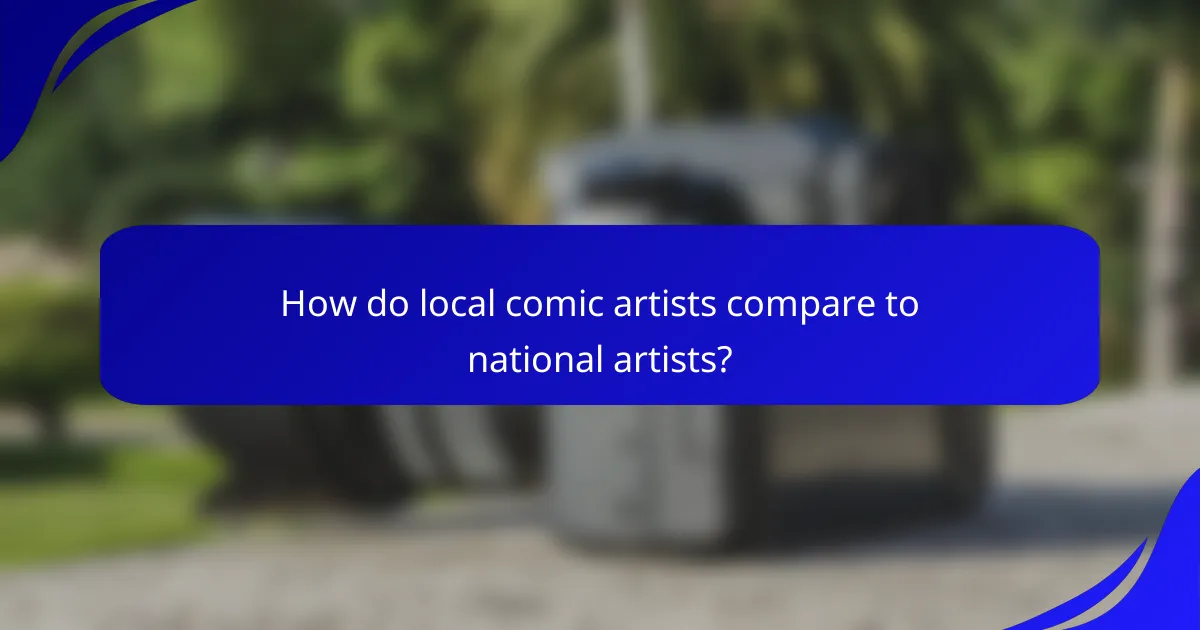
How do local comic artists compare to national artists?
Local comic artists typically have a more limited audience and market reach compared to national artists, who benefit from broader distribution and recognition. However, local artists often cultivate strong community ties and can engage more directly with their audience.
Market reach differences
Local comic artists usually operate within a specific region, which can restrict their audience size to local fans and events. In contrast, national artists can access a much larger market through online platforms and national conventions, allowing them to reach fans across the country.
For local artists, building a loyal customer base is crucial. They often rely on local comic shops, art fairs, and community events to promote their work. Utilizing social media can help expand their reach beyond their immediate area, but it may still be limited compared to national counterparts.
Pricing strategies
Local comic artists often adopt competitive pricing to attract local buyers, which may involve lower prices than national artists. This strategy can be effective in smaller markets, where consumers may have limited disposable income for comics.
Additionally, local artists might offer unique pricing models, such as pay-what-you-want or bundled deals at events. National artists, on the other hand, may have the leverage to set higher prices due to their established brand and wider distribution, often reflecting their broader market reach.
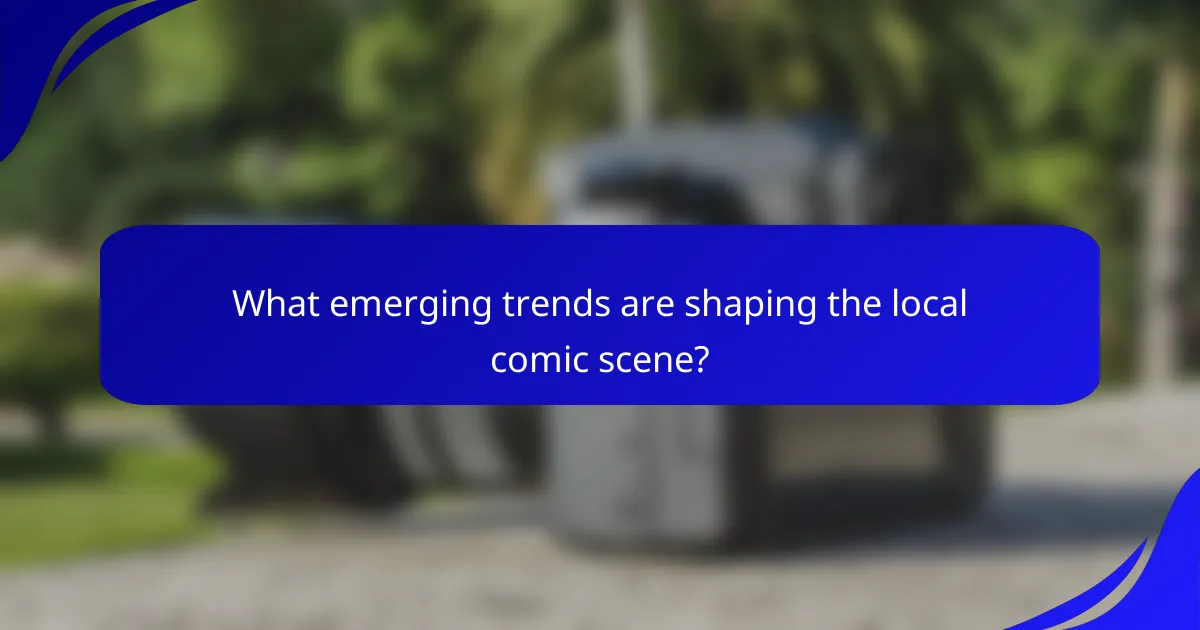
What emerging trends are shaping the local comic scene?
Emerging trends in the local comic scene include the rise of digital comics and webtoons, which are transforming how artists reach audiences and distribute their work. These formats allow for greater accessibility and engagement, catering to diverse reader preferences and expanding market opportunities.
Digital comics and webtoons
Digital comics and webtoons are becoming increasingly popular due to their accessibility and the ease of distribution through online platforms. Artists can publish their work directly to readers without the need for traditional print publishing, which often involves higher costs and longer timelines.
Platforms like Tapas and Webtoon allow creators to monetize their content through ad revenue, subscriptions, or crowdfunding. This model can lead to a more sustainable income stream for artists, especially in regions where print sales may be limited.
For local artists, embracing digital formats can significantly expand their audience reach. By leveraging social media and online communities, they can promote their work effectively, engage with fans, and build a loyal following. However, it’s essential to maintain a consistent posting schedule and actively interact with readers to maximize engagement.
